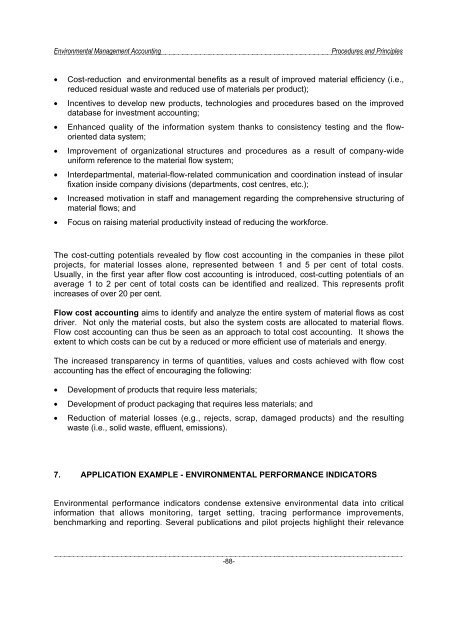Environmental Management Accounting Procedures and Principles
Environmental Management Accounting Procedures and Principles
Environmental Management Accounting Procedures and Principles
You also want an ePaper? Increase the reach of your titles
YUMPU automatically turns print PDFs into web optimized ePapers that Google loves.
<strong>Environmental</strong> <strong>Management</strong> <strong>Accounting</strong><br />
<strong>Procedures</strong> <strong>and</strong> <strong>Principles</strong><br />
• Cost-reduction <strong>and</strong> environmental benefits as a result of improved material efficiency (i.e.,<br />
reduced residual waste <strong>and</strong> reduced use of materials per product);<br />
• Incentives to develop new products, technologies <strong>and</strong> procedures based on the improved<br />
database for investment accounting;<br />
• Enhanced quality of the information system thanks to consistency testing <strong>and</strong> the floworiented<br />
data system;<br />
• Improvement of organizational structures <strong>and</strong> procedures as a result of company-wide<br />
uniform reference to the material flow system;<br />
• Interdepartmental, material-flow-related communication <strong>and</strong> coordination instead of insular<br />
fixation inside company divisions (departments, cost centres, etc.);<br />
• Increased motivation in staff <strong>and</strong> management regarding the comprehensive structuring of<br />
material flows; <strong>and</strong><br />
• Focus on raising material productivity instead of reducing the workforce.<br />
The cost-cutting potentials revealed by flow cost accounting in the companies in these pilot<br />
projects, for material losses alone, represented between 1 <strong>and</strong> 5 per cent of total costs.<br />
Usually, in the first year after flow cost accounting is introduced, cost-cutting potentials of an<br />
average 1 to 2 per cent of total costs can be identified <strong>and</strong> realized. This represents profit<br />
increases of over 20 per cent.<br />
Flow cost accounting aims to identify <strong>and</strong> analyze the entire system of material flows as cost<br />
driver. Not only the material costs, but also the system costs are allocated to material flows.<br />
Flow cost accounting can thus be seen as an approach to total cost accounting. It shows the<br />
extent to which costs can be cut by a reduced or more efficient use of materials <strong>and</strong> energy.<br />
The increased transparency in terms of quantities, values <strong>and</strong> costs achieved with flow cost<br />
accounting has the effect of encouraging the following:<br />
• Development of products that require less materials;<br />
• Development of product packaging that requires less materials; <strong>and</strong><br />
• Reduction of material losses (e.g., rejects, scrap, damaged products) <strong>and</strong> the resulting<br />
waste (i.e., solid waste, effluent, emissions).<br />
7. APPLICATION EXAMPLE - ENVIRONMENTAL PERFORMANCE INDICATORS<br />
<strong>Environmental</strong> performance indicators condense extensive environmental data into critical<br />
information that allows monitoring, target setting, tracing performance improvements,<br />
benchmarking <strong>and</strong> reporting. Several publications <strong>and</strong> pilot projects highlight their relevance<br />
-88-




